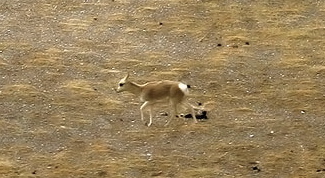Talk:Tibetan antelope
| This article is rated C-class on Wikipedia's content assessment scale. It is of interest to the following WikiProjects: | |||||||||||||||||||||||||||||||||||||||||
| |||||||||||||||||||||||||||||||||||||||||
Requires Killing??
[edit]Okay, so on the Shahtoosh page, it says that the animal sheds its down, and that nomads used to gather it this way. Then on the animal's page here, it says that you can't get the material without killing the creature. Which is accurate? Someone please coordinate! Kilyle 19:25, 8 July 2006 (UTC)
The species is listed in the IUCN Red List and is included in CITES. It is a major target species of TRAFFIC International -- clearly they all believe that the shahtoosh trade is endangering the species!!! --GRM 10:12, 2 November 2006 (UTC)
No controversy?
[edit]Should there be mention of the controversy or not? Erik-the-red
- What controversy? Bob the Wikipedian (talk • contribs) 22:06, 3 February 2009 (UTC)
Origin of the name "chiru"
[edit]This word is not from Tibetan or Ladakhi. I have asked Tibetans, Kargilis, Baltis and dozens of Ladakhis including some who know Urdu, Hindi, Kashmiri, Farsi, or Tibetan, and this word "chiru" is definitely not from any language my informants know, although I have not checked with Nepali-speakers. It seems to have originated with an early European traveller, who may have had his leg pulled by locals about it being a unicorn. I posted a question in Ladakh Studies 17 (the Bulletin of the International Association for Ladakh Studies) and got this reply from David Mallon in Ladakh Studies 18, December 2003:
“I have been intrigued by the origin of the word chiru for a long time. I have asked Ladakhis, Changpa from Kharnak, and Tibetans from all parts of the [Tibetan] Plateau about it, and no-one has ever heard the term. As Rebecca Norman wrote in Ladakh Studies 17 (p. 32), they all use some variant of tso / tsos. ... It is called orongo by Mongolian speakers around Koko Nor/ Qinghai Hu. Indian zoological colleagues are equally sure it is not of Hindi/Urdu origin either. “ It seems likely, based on a reference in Abbe Huc’s Voyages, that chiru is a corruption of the Tibetan gcig-ru meaning one-horn (several early authors remarked on the animal’s resemblance to the mythical unicorn). “The earliest mention I have found is by Lesson, 1872, who referred to ‘Antelope chiru’ from Nepal. A British zoologist in 1830 also wrote of the ‘chiru antelope’. Sterndale’s (1884) Mammalia of British India lists among local names “chiru in Nepal.” — Preceding unsigned comment added by BeckyLadakh (talk • contribs) 14:22, 27 December 2010 (UTC)
Wrong picture (?)
[edit]
I think the currently illustrating the page is not a Tibetan antelope, but a goa (Procapra picticaudata). As the image is used in almost every WP project for Pantholops hodgsonii (Tibetan antelope), I would appreciate a confirmation by other editors before doing massive reverts. Thanks--Pseudois (talk) 13:15, 19 July 2012 (UTC)
- It being either female or young doesn't help, as we have no horns to go by. However, I believe that the white rump with black tail is a characteristic feature of Pr. picticaudata, and it is certainly not present in the only picture of a (male) Pa. hodgsonii that I have access to. Since the animal in the picture clearly has this marking, I believe you are correct. Anaxial (talk) 18:41, 19 July 2012 (UTC)
- Managed to find a picture of a female - looks quite different to the animal in this image. I've tagged the image file at the Commons accordingly. Anaxial (talk) 20:41, 19 July 2012 (UTC)
Need better photo
[edit]The first picture (which is apparently the wrong animal anyway) is too small to see what the animal looks like. Then scrolling down we have a better view, except it's of a decaptitated head. Somehow, I find that in poor taste. — Preceding unsigned comment added by 24.246.17.50 (talk) 14:20, 30 September 2012 (UTC)
- C-Class Tibet articles
- Low-importance Tibet articles
- WikiProject Tibet articles
- C-Class China-related articles
- Low-importance China-related articles
- C-Class China-related articles of Low-importance
- WikiProject China articles
- C-Class mammal articles
- Mid-importance mammal articles
- WikiProject Mammals articles
- C-Class Nepal articles
- Low-importance Nepal articles
- WikiProject Nepal articles


